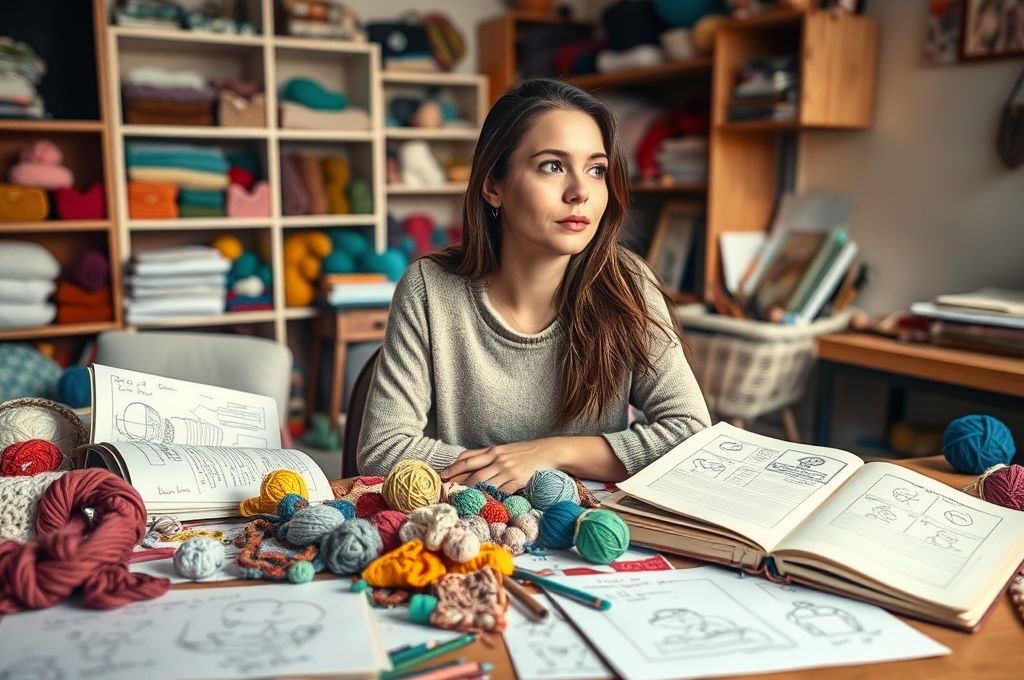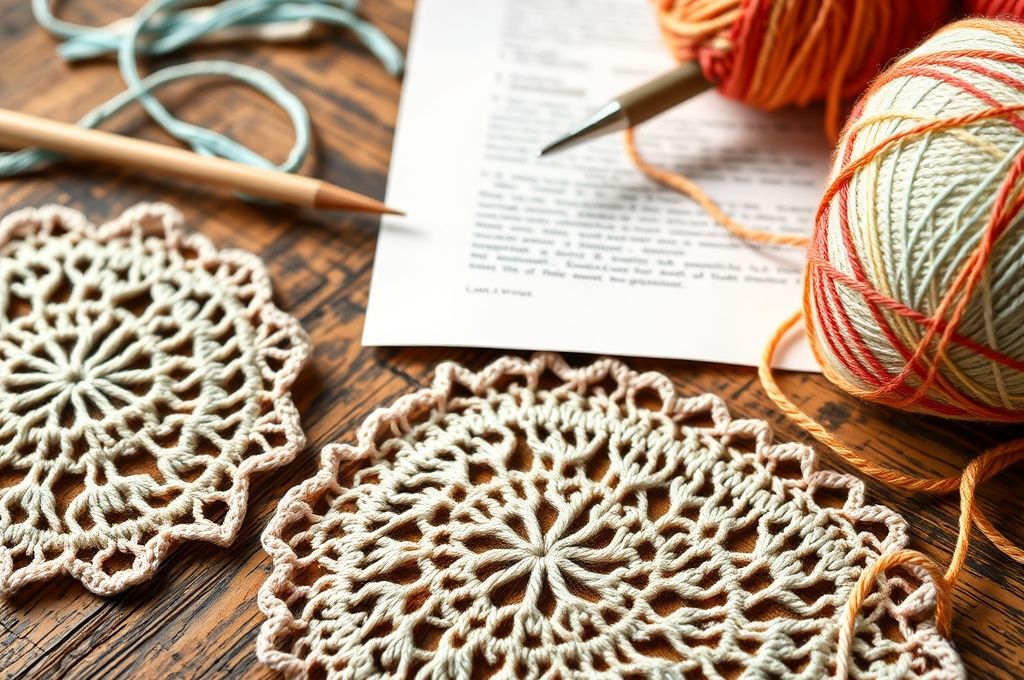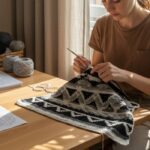Imagine spending weeks designing the perfect crochet pattern—a cozy, modern blanket with a unique stitch that flows like water. You finally publish it online, proud of your creativity. But just days later, you find the exact same design being sold on another website, with no credit to you. It’s not just frustrating—it’s a violation. This is where copyright comes in.
Crochet isn’t just a hobby—it’s an art form, a business, and for many, a livelihood. Whether you’re a hobbyist sharing free patterns or a professional selling digital downloads, your crochet designs are yours. But how do you protect them? And what rights do you actually have?
In this article, we’ll explore the often-misunderstood world of copyright as it applies to crochet. From understanding what can and can’t be copyrighted, to practical steps you can take to safeguard your work, we’ll break it down in plain, easy-to-understand language. You’ll learn how to register your patterns, what to do if someone steals your design, and how to respect others’ work while protecting your own.
Whether you’re just starting out or have been crocheting for years, this guide will empower you to create with confidence—knowing your creativity is legally protected. Let’s unravel the truth about copyright and crochet.
What Is Copyright, and Why Does It Matter for Crocheters?
Copyright is a form of legal protection for original works of authorship that are fixed in a tangible medium. In simpler terms: if you create something unique and write it down, draw it, or save it digitally, it’s automatically protected by copyright the moment it’s created.
For crocheters, this applies to written patterns, diagrams, charts, photographs of your work, and even blog posts or videos explaining your techniques. What it doesn’t protect is the idea of a crochet design—like a heart-shaped baby blanket or a granny square tote bag. But the specific way you write the instructions? That’s protected.
Let’s say you invent a new stitch sequence and write a detailed pattern with step-by-step photos. That pattern is yours. Someone else can create a similar-looking blanket, but they can’t copy your exact instructions or photos without your permission.
Why does this matter? Because crochet has exploded in popularity. Platforms like Etsy, Ravelry, and Instagram have turned handmade crafts into global businesses. With over 20 million crochet patterns available online (according to Ravelry’s database), originality is more valuable—and more vulnerable—than ever.
Without copyright awareness, your hard work could be copied, resold, or even claimed by someone else. Understanding your rights isn’t about being paranoid—it’s about respecting your own creativity and ensuring fair use in the crafting community.
What Can (and Can’t) Be Copyrighted in Crochet?How to Be Inspired Without Infringing on Others’ Work

Now that we know copyright protects original expression, let’s get specific. Not everything related to crochet is eligible for protection. Here’s a clear breakdown:
✅ What Can Be Copyrighted:
- Written crochet patterns (including stitch sequences, instructions, and formatting)
- Photos and videos of your finished projects
- Charts, diagrams, and schematics
- Blog posts, tutorials, and e-books
- Brand names and logos (under trademark, not copyright)
❌ What Cannot Be Copyrighted:
- The idea of a crochet item (e.g., a beanie, amigurumi fox, or shawl)
- Standard stitch names (single crochet, double crochet, etc.)
- Basic techniques or methods (like how to do a magic ring)
- Functional aspects of a design (e.g., how a garment fits or is worn)
Think of it this way: You can’t copyright the concept of a crocheted dinosaur, but you can copyright the specific pattern you write for your T-Rex with googly eyes and tiny arms.
A real-world example? In 2018, a crochet designer discovered that a major craft company had copied her original amigurumi unicorn pattern and sold it as their own. She was able to take legal action because she had registered her copyright and had proof of original creation.
This distinction is crucial. It means you’re free to be inspired by others’ work (which is how creativity grows!), but you can’t copy their expression—their exact words, photos, or layout—without permission.
So, if you’re designing a pattern inspired by a popular TV show character, you can create a similar creature, but avoid using copyrighted names, logos, or direct references that could infringe on intellectual property.
How to Protect Your Crochet Patterns: Simple Steps You Can Take Today
You don’t need a law degree to protect your crochet work. Here are five practical, easy-to-follow steps to safeguard your designs:
- Write It Down (and Save It)
As soon as you finish a pattern, save it in a dated format—PDF, Word doc, or even a printed copy. This creates a timeline of your creation. Use cloud storage (like Google Drive or Dropbox) with timestamps for extra proof. - Add a Copyright Notice
Include a simple line at the bottom of your pattern:
© [Year] [Your Name]. All rights reserved.
This isn’t legally required (copyright exists automatically), but it signals to others that you’re serious about protection. - Watermark Your Photos
If you’re sharing photos of your work online, add a small watermark with your name or brand. This discourages unauthorized use and helps trace stolen images. - Register Your Copyright (Optional but Powerful)
In the U.S., you can register your work with the U.S. Copyright Office (copyright.gov). It costs $45–$65 per submission and gives you stronger legal standing if you ever need to sue for infringement. You can register multiple patterns in one batch under a “collection.” - Use Licensing Agreements
When selling or sharing patterns, consider adding a short license. For example:
“This pattern is for personal use only. Redistribution, resale, or mass production is prohibited without written permission.”
These steps don’t take much time, but they build a strong foundation. Think of it like locking your front door—you hope you never need it, but it’s there when you do.
Real-Life Scenarios: What Happens When Someone Steals Your Design?
Let’s look at two real stories from the crochet community.
Case 1: The Etsy Copycat
Sarah, a crochet designer from Oregon, noticed a nearly identical pattern being sold on Etsy under a different name. The photos were different, but the instructions were word-for-word the same. She had registered her copyright and sent a DMCA (Digital Millennium Copyright Act) takedown notice to Etsy. Within 48 hours, the listing was removed, and the seller was warned.
Case 2: The Viral Instagram Post
Jamal created a stunning crochet jacket pattern and shared a photo on Instagram. A fast-fashion brand saw it, recreated the design, and sold it for $120—without credit. Jamal didn’t have a registered copyright, but he had dated posts and original photos. He contacted the brand, and after public pressure, they issued an apology and donated proceeds to a craft charity.
These cases show that action can be taken—but preparation matters. If you don’t have proof of ownership, it’s much harder to defend your rights.
So, what should you do if you find your design copied?
- Document Everything
Take screenshots of the infringing content, including URLs and dates. - Contact the Person
Send a polite message: “I noticed your pattern is very similar to mine. I’d appreciate it if you could credit me or take it down.” Many times, it’s an honest mistake. - File a DMCA Takedown
If they don’t respond, file a formal notice with the platform (Etsy, Facebook, Ravelry, etc.). Most sites have a process for this. - Consult a Lawyer (If Necessary)
For large-scale theft or financial loss, a legal professional can help. Some designers even use services like Creative Commons or Copyleaks to monitor for plagiarism.
Remember: Standing up for your work isn’t about being aggressive—it’s about valuing your time, talent, and creativity.
How to Be Inspired Without Infringing on Others’ Work

Creativity thrives on inspiration. It’s natural to see a beautiful crochet shawl and want to make your own version. But where’s the line between inspiration and infringement?
Here’s a helpful analogy: Think of recipes. Anyone can make chocolate chip cookies, but if you copy Julia Child’s exact recipe, wording, and photos without permission, that’s a problem. Similarly, anyone can make a granny square blanket, but copying a designer’s specific pattern isn’t okay.
So how can you stay inspired while staying legal?
- Reinterpret, Don’t Replicate
See a cool color block design? Try using different yarns, stitch patterns, or shapes to make it your own. - Credit When You Can
If you’re clearly inspired by someone’s work, mention them: “Inspired by @CrochetQueen’s bold color choices!” - Avoid Copying Photos or Layouts
Even if you rewrite the pattern, using someone else’s photos or formatting can still be infringement. - Use Free or Licensed Resources
Some designers offer “designer rights” patterns—these allow limited commercial use. Always read the license terms.
The crochet community is built on sharing and kindness. By respecting others’ work, you help maintain a culture of trust and creativity.
Using Copyright to Grow Your Crochet Business
Did you know copyright can actually help you grow your business?
When customers see a copyright notice on your pattern, it signals professionalism. It tells them: This is original, high-quality work.
Here’s how to turn copyright into a business advantage:
- Sell Licensed Versions
Offer a “small business license” for crafters who want to sell items made from your pattern. Charge a small fee (e.g., $10) and provide a certificate of permission. Many designers earn passive income this way. - Create Exclusive Content
Use copyright to protect premium patterns sold on your website or through Patreon. This encourages people to support you directly instead of seeking free copies. - Build a Brand
Consistently using your name, logo, and style makes your work recognizable. Over time, your brand becomes valuable—just like a fashion label. - Collaborate with Confidence
When working with magazines or yarn companies, having registered copyrights gives you leverage in negotiations.
For example, designer Mei Lin registered her popular “Ocean Wave Shawl” pattern and later licensed it to a yarn company for a paid kit. She earned royalties while gaining exposure to thousands of new customers.
Copyright isn’t just a shield—it’s a tool for growth.
Common Myths About Copyright and Crochet—Debunked
Let’s clear up some widespread misconceptions:
❌ Myth 1: “If it’s online, it’s free to use.”
Truth: Just because something is public doesn’t mean it’s free. Posting a pattern online doesn’t give others permission to copy it.
❌ Myth 2: “I changed a few stitches, so it’s mine now.”
Truth: Minor changes don’t make a copied pattern original. If the core structure is the same, it’s still infringement.
❌ Myth 3: “Copyright only matters if I’m making money.”
Truth: Even free patterns are protected. Giving something away doesn’t strip your rights.
❌ Myth 4: “I don’t need to register—copyright is automatic.”
Truth: While true that copyright exists upon creation, registration is required to sue for damages in the U.S. It’s like having insurance—you hope you never need it, but it’s essential when you do.
❌ Myth 5: “I can use cartoon characters in my designs.”
Truth: No. Characters like Mickey Mouse or Pikachu are trademarked and copyrighted. Creating and selling a crocheted Pikachu is a legal risk.
Understanding these myths helps you avoid costly mistakes and protects both you and the wider crafting community.
How to Respect Copyright as a Crocheter (Even If You’re Not a Designer)
Even if you’re not creating patterns, you play a role in the copyright ecosystem.
Here’s how to be a responsible crocheter:
- Buy Patterns Legally
Support designers by purchasing their work instead of searching for free downloads. A $5 pattern helps fund their creativity. - Don’t Share PDFs
Forwarding a pattern to a friend might seem harmless, but it’s like sharing a paid e-book. Encourage them to buy their own copy. - Credit Designers on Social Media
When posting a finished project, tag the designer and mention the pattern name. It’s a small gesture that means a lot. - Follow Commercial Use Rules
If a pattern says “for personal use only,” don’t sell the items. Some designers allow sales with a small license fee—check the terms. - Report Theft When You See It
If you spot a copied pattern, let the original designer know. The community is stronger when we look out for each other.
Respecting copyright isn’t about rules—it’s about respect. Every stitch has time, love, and thought behind it. Recognizing that keeps the craft world fair and flourishing.
International Copyright: What If You’re Not in the U.S.?
Copyright laws vary by country, but there’s good news: most nations follow international agreements like the Berne Convention, which means your work is likely protected in over 180 countries.
For example:
- In the UK and EU, copyright is automatic and lasts 70 years after the creator’s death.
- In Canada, it’s similar—life of the author plus 50 years (soon changing to 70).
- In Australia, protection is automatic and lasts 70 years post-death.
While registration isn’t required in most countries, it can still help in disputes. Some designers choose to register in the U.S. because the process is straightforward and widely recognized.
If you sell globally (via Etsy, Ravelry, or your own site), it’s wise to include a simple copyright notice and terms of use in your patterns. You might also consider using a service like Creative Commons to specify how others can share or use your work.
The key takeaway? Your creativity has value everywhere. Don’t assume your rights don’t apply just because you’re not in the U.S.
Teaching and Sharing: Where Does Fair Use Apply?
“Can I teach a class using someone else’s pattern?” This is a common question.
The answer? Generally, no—unless you have permission.
“Fair use” is a U.S. legal doctrine that allows limited use of copyrighted material without permission for purposes like criticism, comment, news reporting, teaching, or research. But it’s narrow and case-specific.
For example:
- ✅ Allowed: Showing a short excerpt of a pattern in a classroom to discuss stitch techniques.
- ❌ Not Allowed: Handing out full copies of a paid pattern to students.
If you’re a teacher or crochet group leader:
- Use original patterns you’ve created.
- Get written permission from designers to use their work.
- Recommend that students purchase the pattern themselves.
Some designers even offer “class licenses” for group use. It’s a win-win: you get to teach, and they get fair compensation.
Remember: Sharing is caring, but only when it’s done the right way.
The Future of Copyright in the Crafting World
As AI and digital tools evolve, new challenges arise. Can an AI generate a crochet pattern based on your work? Could someone scan your design and mass-produce it with a 3D crochet printer?
These aren’t sci-fi scenarios—they’re real concerns. In 2023, a designer discovered that an AI art generator was creating “crochet-style” images based on her copyrighted photos. She filed a complaint, and the images were removed.
The future of copyright will likely involve:
- Stronger digital watermarking
- Blockchain-based ownership tracking
- Clearer laws around AI-generated content
But one thing won’t change: the value of human creativity. No algorithm can replicate the love, patience, and soul that go into a handmade piece.
By staying informed and proactive, you’re not just protecting your work—you’re preserving the heart of the craft.
Conclusion: Stitch by Stitch, Protect Your Passion
Crochet is more than yarn and hooks—it’s a form of self-expression, storytelling, and sometimes, a business. Your patterns are the blueprint of your imagination, and they deserve protection.
We’ve covered a lot: what copyright is, what it protects, how to enforce it, and how to respect others’ work. The key takeaway? You don’t need to be a lawyer to protect your designs. Start small—add a copyright notice, save your files, and be mindful of where you share your work.
Your creativity matters. Whether you’re making a blanket for your niece or launching a pattern empire, your ideas have value. And when you protect them, you’re not just defending your rights—you’re honoring the time, skill, and love you pour into every stitch.
So go ahead: design boldly, share generously, and create fearlessly. And the next time you publish a pattern, take a moment to add that little © symbol. It’s a small mark with a big meaning.
Now, we’d love to hear from you: Have you ever had your work copied? Or have you accidentally used someone else’s pattern without realizing? Share your story in the comments below—let’s learn and grow together.
And if you found this guide helpful, please share it with a fellow crocheter. Because when we protect creativity, we all benefit.
Happy crocheting—and happy creating!

Daniele Ferreira is passionate about the world of crochet, dedicating her time to exploring techniques, creating unique pieces, and sharing her knowledge with beginners and aficionados alike. With attention to detail and creativity, she transforms yarn into true works of art, inspiring others to discover the beauty and joy of this manual art.







